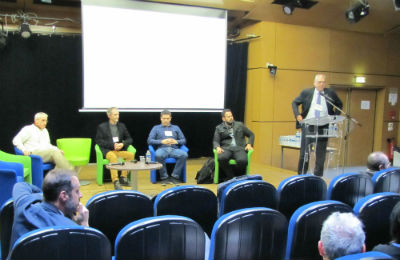SYSTEMS
Scientists from Lyon, São Paulo present technologies that enable light in quantum supercomputing systems at FAPESP Week France
The researchers covered integrated photonics, nanotechnology, and quantum entanglement, among other fields that have broadened the research possibilities in optical communication systems and could support the development of quantum supercomputers.
“Quantum characteristics inspire new concepts in information science, in a context in which efficiencies in computing, storage, and information transport can be increased,” said Paulo Nussenzveig, a full professor at the University of São Paulo’s Physics Institute (IFUSP), at the symposium held in Lyon and Paris until November 27th of 2019.
Nussenzveig spoke about quantum information with multiple modes of light and highlighted that quantum light is suitable not only for communication but also for supercomputing.  {module INSIDE STORY}
{module INSIDE STORY}
The researcher also spoke about another highly important concept in studies for developing quantum information transmission devices: entanglement.
Quantum entanglement is a phenomenon of quantum mechanics according to which two or more objects (which can be waves or particles) are so interlinked that one object cannot be correctly described without the other being mentioned, even if they are separated by millions of kilometers. This leads to very strong correlations between the observable physical properties of various subatomic particles.
Nussenzveig remembered what Einstein, Podolsky and Rosen Due wrote when they introduced the concept of quantum entanglement, “measures in one particle provide information about the state of another particle. Since, at the time of measuring, the systems are not interacting, no change can occur in the second system as a consequence of something that occurs in the first system,” said Nussenzveig.
In an experiment carried out by Marcelo Martinelli’s and Nussenzveig’s group at IFUSP, the researchers managed to obtain an entanglement of six light waves, generated by a laser beam source developed by the scientists, called an Optical Parametric Oscillator (OPO).
The results of the research – conducted within the scope of the Thematic Project “Exploring quantum information with atoms, crystals, and chips,” with FAPESP’s support, conducted by Martinelli – were published in the journal Physical Review Letters, in 2018.
Previously, in 2009, the group at IFUSP obtained the entanglement of three light waves. The research was published in Science.
Integrated quantum photonics
Felippe Alexandre Silva Barbosa, of the Gleb Wataghin Institute of Physics of the University of Campinas (UNICAMP), spoke about integrated quantum photonics in the same session at FAPESP Week France.
“In integrated photonics, the main objective is to develop technologies that enable information to be codified, transmitted, and processed using light,” said Barbosa, who is also carrying out research with the Optical Parametric Oscillator together with Nussenzveig and Martinelli – all three are authors of the 2018 article in Physical Review Letters.
“The area of integrated photonics has been at the front line of scientific and technological research for more than a decade. More recently, developments in integrated photonics platforms have led to progress in other fields, such as non-linear optics, microfluidics, machine learning, and quantum information,” he said.
According to Barbosa, many advances in the areas of quantum information and integrated photonics have helped to “push the limits both in fundamental scientific research and in cutting-edge technology.”
“In the last few years, there has been a growing intersection between these two areas of research, resulting in the emerging field of integrated quantum photonics,” he said. With FAPESP’s support, Barbosa is carrying out a research project whose main objective is to study this new field.
“The research is focused on preparing compressed and entangled states of individual photons, using thin films of silicon nitride and lithium niobate, two scalable and integrated photonic platforms,” he said.
Nanotechnology in Lyon
“The Lyon Institute of Nanotechnology is a collaborative structure with a presence in various campuses of the University of Lyon. We are around 200 people working in materials science and on new concepts of devices and systems integration,” said Christian Seassal, assistant director of the Lyon Institute of Nanotechnology, to Agência FAPESP.
One of the speakers at FAPESP Week France, Seassal mentioned that the Lyon Institute of Nanotechnology has research in four main areas: Functional Materials; Electronics; Photonics and Photovoltaic Energy; and Biotechnology and Materials Engineering.
“Since 2007, we have worked with dedicated technologies in terms of functional oxides, semiconductor materials, nanomaterials including nanowires, for example, and on new concepts in information processing, energy generation, biotechnology, and health, among others,” he said.
Photonic crystals, nanotechnological systems integration, silicon photovoltaic devices, biomedical sensors, intelligent clothing, and nanofluids are other research topics at the Lyon Institute of Technology.

